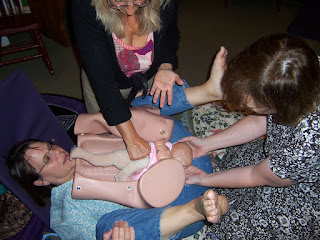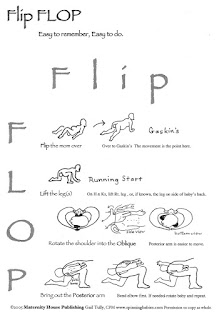Will Shoulder Dystocia Occur?
2017-03-08 |
Birth Anatomy,
Birthing

A doula friend of mine, “J,” asks how real the concern is that a mother with an estimated projected fetal weight of 11 pounds by the time of the due date will have a shoulder dystocia.
“They had her see the OB and heard the reasons for perhaps choosing a repeat surgical birth. She was told that if gestational diabetes is back that they see these big babies with a weight distribution in the upper body (shoulders) that could be problematic during birth. …
This mama is hoping for a vaginal birth but she is philosophical about the whole thing. She knows there are no assurances but feels she needs more info right now. She is wondering about continuing the Spinning Babies stuff she has been doing. Her abdomen is pendulous and she has been using a rebozo to get some relief for the back discomfort she is having…
Thanks for being out there doing what you do.
Gratefully,
Gail Tully responds
Dear J
Hi. I can only share what I would have recommended as a midwife. As a doula I would not have made statements about my opinion of risk or stated recommendations in the following way. This is my post-midwife voice here.
Movement, good nutrition for her blood type (meaning a serving or two of grains and milk products for the Os and As) while getting good protein and veggies, salt-to-taste and water. Minerals help reduce sugar cravings. Red Raspberry Leaf with Alfalfa steeped together is really amazing.
Wearing a pregnancy belt and getting balancing work down, she can have her helper (you?) do standing release with her.
The pendulous uterus is more of a risk for shoulder dystocia than the baby’s size alone. Ultrasounds can be off, of course. and her chance of no shoulder dystocia is somewhere around 4 out of 5 if this info is accurate, between the hanging uterus and large baby. What will improve her chance of no obstruction?
- Wearing the pregnancy belt all the way through the birth of the shoulders!
- Balance and good diet for good metabolic function!
- Supple sacrum
- Avoiding a vacuum or forceps
- Upright birth position and
- AFTER the head is born, in any maternal position, a posterior pelvic tilt (which can be done preventively during ONE contraction in 2nd stage.
The pregnancy belt, the right one for her, could be amazing.
Talking to an Obstetrician/surgeon a
bout benefits of cesarean is like talking to a plumber about home improvement. Yes, new pipes may avoid a clogged drain now, but if you had hoped for a consultation on paint colors you are going to go home worrying about potential plumbing problems. It can haunt you. Especially as birth is more important than a broken pipe. But I’m talking perspective. If her midwives are not able to resolve a shoulder dystocia, and the doctors weren’t able to help her first baby be born breech vaginally, then what skills is she expecting from them that they don’t also have?
bout benefits of cesarean is like talking to a plumber about home improvement. Yes, new pipes may avoid a clogged drain now, but if you had hoped for a consultation on paint colors you are going to go home worrying about potential plumbing problems. It can haunt you. Especially as birth is more important than a broken pipe. But I’m talking perspective. If her midwives are not able to resolve a shoulder dystocia, and the doctors weren’t able to help her first baby be born breech vaginally, then what skills is she expecting from them that they don’t also have?
There are known side effects to a repeat cesarean (she knows she will have major surgery, separation from her baby, and significant blood loss, postpartum pain in the abdomen, not able to lift or do stairs for a longer time, the risks are that she might have infection, adhesions, problems with a future pregnancy, etc. etc. and there are unknown side effects to a VBAC, such as a sore perineum, possible hemorrhoids, etc. Which is most beneficial if they go well? Cesarean offers a feeling of certainty (though not assurance) and vaginal birth offers the unknown. But vaginal birth also offers hormonal changes from labor, the finish of the hormonal cycle of reproduction with subsequent brain change and probiotic activity, and can be easier to maintain mother/baby togetherness from the start, spontaneous or at least, immediate breastfeeding is more possible but can happen or not happen with either surgery or vaginal birth.
She may have a shoulder dystocia. She may not. I don’t dismiss the potential but I don’t dismiss vaginal birth because of this person’s risk. If she does have a SD, she flattens her lower back while her providers figure out how to rotate the shoulders free. The chance of injury to the baby is about 7 in 100 and reduces to less than 2% when providers do practice drills (Crofts 2014). Permanent injury is also low risk. Death is less but not zero.
The thing she can ask herself is, who does she want to be a year from now looking back at her birth?
What does she want and what is the next action to take to get that? And to remind herself several times a day to hold that vision in her head and body. Asking our bodies to avoid a complication is wrong. Because the mind doesn’t hear no, don’t, avoid. Ask the body to release, open, birth (as a verb). The physiology-first mind set.
Thank you for your continuing care of our mothers, Doula!
Much love,
Gail


